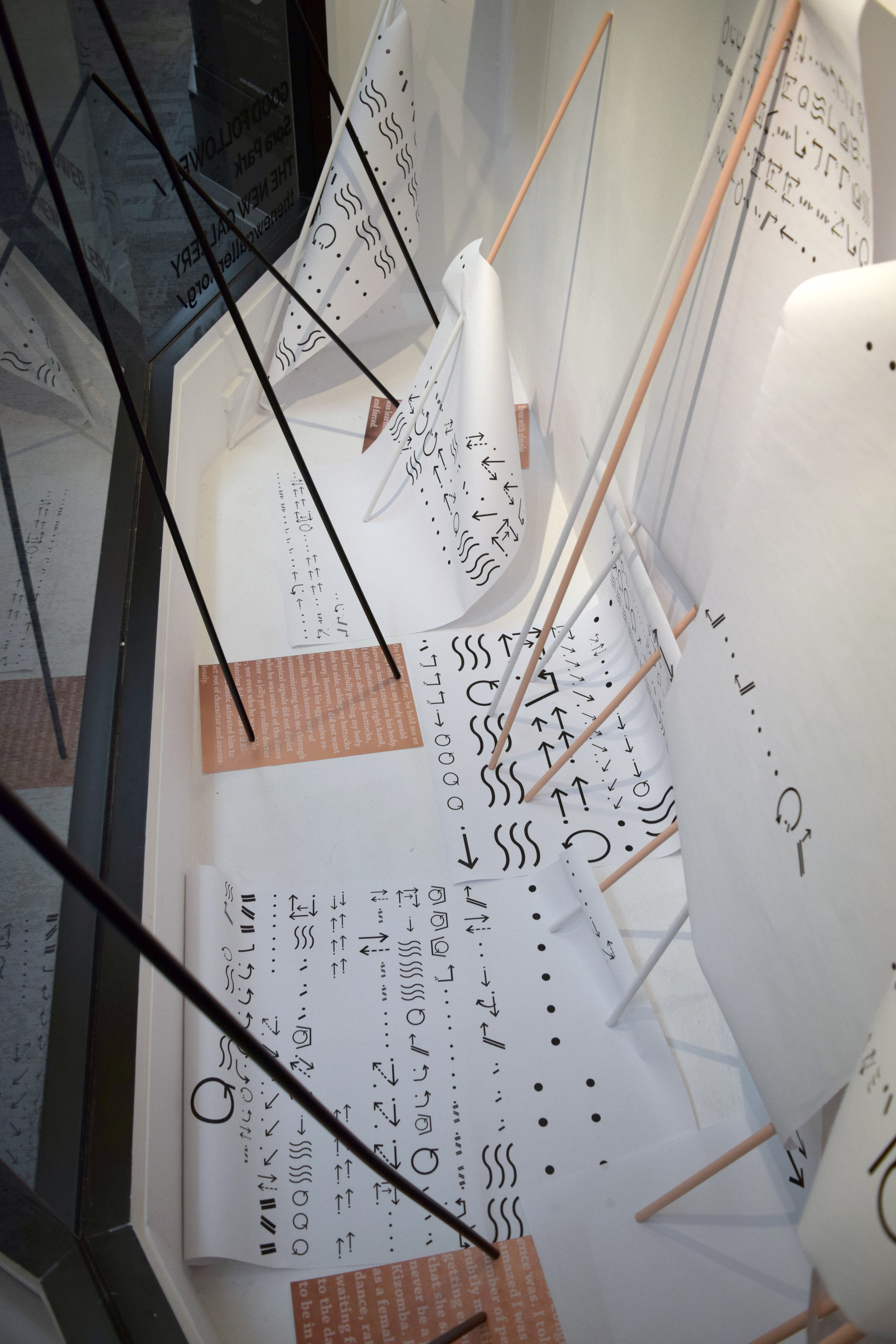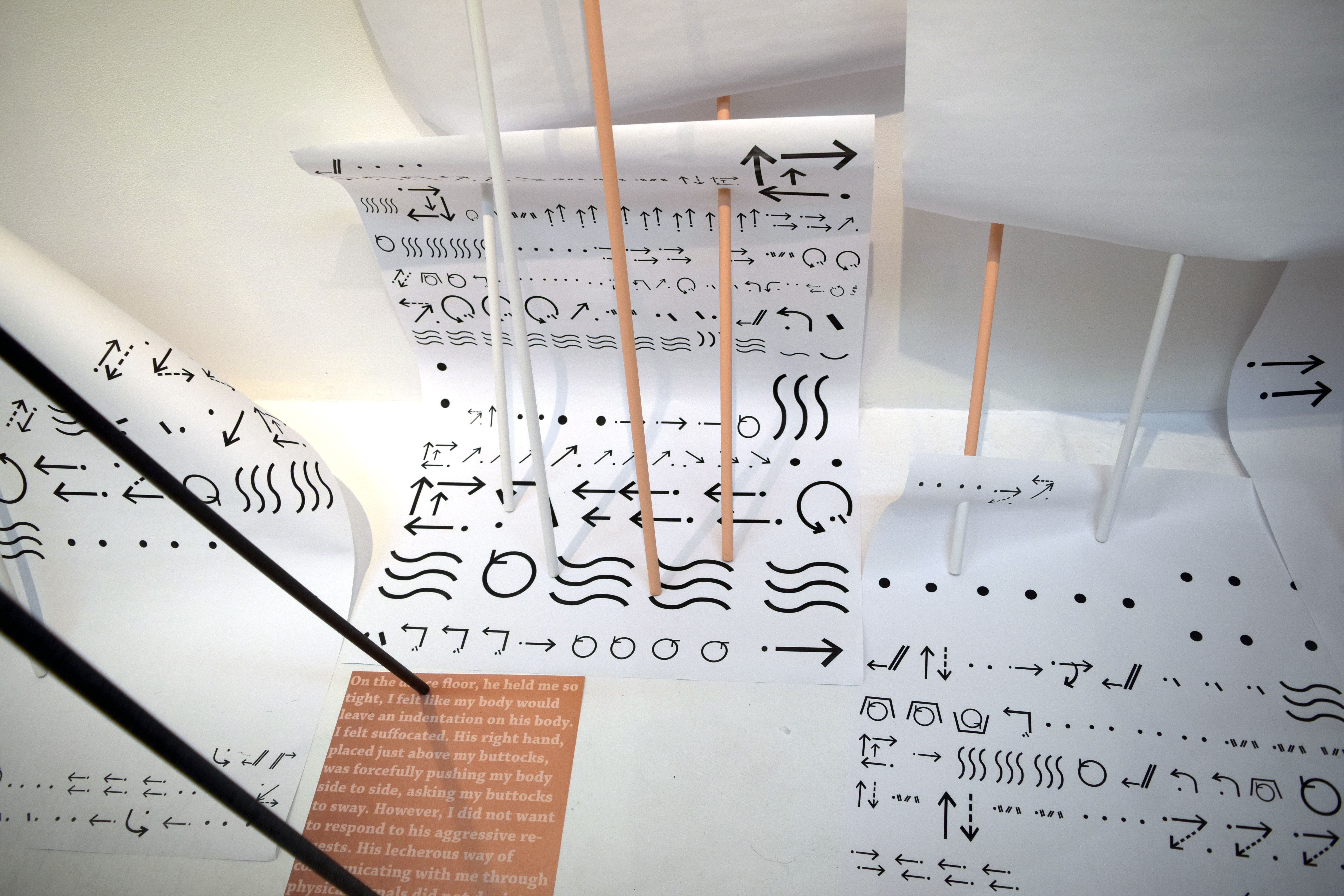
Good Follower
Sora Park
March 26 – May 25, 2018
+15 Window Exhibition
Exhibition Description
On the dance floor, he held me so tight, I felt like my body would leave an indentation on his body. I felt suffocated. His right hand, placed just above my buttocks, was forcefully pushing my body side to side, asking my buttocks to sway. However, I did not want to respond to his aggressive requests.
On my drive home with fresh summer air circulating in my car, I felt disgusted by the dance that I once loved so much.
As I commiserated with myself on the deplorable experiences I had tonight, I suddenly felt the heightened awareness of my body being that of a female body, and what was expected of me as a female follower to participate in a partner social dancing community now.
Good Follower is a project that utilizes made-up symbols and linguistic cues – both illegible and legible – to depict the artist’s body, a female body, as it goes through a process of learning how to intentionally oppose socially constructed heteronormative behaviors, particularly practiced within social dancing subcultures.
The communication that occurs between two bodies as they engage in social dancing has been noted by the dancers as an esoteric language composed of verbal, non-verbal, physical cues and slangs. It is a language that contains and allows this dancing subculture to continually function.
As a female follower of partner social dancing, the artists body constantly receives sexualized moves seen on YouTube videos of famous instructors: the accentuated hip swaying side to side, grinding of lower bodies and waving upper body against the leaders body. The exuding of submissiveness on a female dancer’s part is almost always required to follow a male leader dictating the dance. What makes the artist feel uncomfortable as a follower is that the power relation embedded in the dichotomy of feminine subservient and masculine machismo is exercised by male leaders through their moves, prior to learning how to execute the moves well. By perceiving the popular dancing style easily seen on YouTube as a sexualized style, some male leaders’ execution of certain dance moves are determined by their perception of the dance. Even with simple steps such as walking side to side or walking forward, they tend to insert sexual energy into simple moves and demand physical and emotional responses from female dancers in accordance to their demands. The sexual energy they are communicating with the artist’s body – the female body – never felt genuine; it is learned, copied and forced.
Good Follower portrays how written and legible text function in conjunction with illegible symbols created based on non-verbal communication of bodies on the dance floor. The tension and harmony co-existing and working off each other through the presence of “cues” – symbols and texts – will provide an atmosphere of the dance floor where the viewers visiting The New Gallery’s +15 Window at Arts Commons are forced to comprehend the lived body experience that the artist, a female dancer, goes through frequently on the dance floor.



Biography
Her research-based practice deals with an ethnographical and anthropological interpretation of subcultures and various issues that emerge during a research period.
She explores how quantitative and qualitative data gathered during an immersive practice of field research translates into works of art through text, performance, media and installation. She emphasizes on a concept of translation in art production as collected data transforms itself into different mediums and is depicted as tangible artworks. Her works provide a glimpse into specific subcultures and issues that many people may not be aware of.
Her most recent projects deal with a three-year long research of Afro-Latin social dancing subcultures around the world. She investigated various issues that emerged when a cultural product, such as dance, migrates out of a country of origin and is interpreted by different cultures. Some of her research interests during this three year period included passion as a cultural commodity, gender politics within social dancing, ownership based on race, social hierarchy, archive, and creation of national identity and patriotism through exported cultural products.
She received her BFA in Photography from Emily Carr University of Art and Design in Vancouver, Canada and her MA in Fine Art from Bergen Academy of Art and Design in Bergen, Norway.
